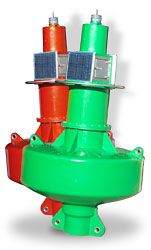Ocean Buoy 1750 Yellow

The Ocean Buoy 1750 Buoy is manufactured from UV stabilized polyethylene, has been specifically designed to withstand the harsh marine environment, and boasts a huge 23mm wall thickness - making it one of the toughest polyethylene buoys on the market. The buoy has a 2.5 meter focal height (up to 3 meters with extension), and a 1.75 meter diameter.
1750 is a lightweight, low-maintenance, cost-effective approach to traditional floating aids. The buoy consists of 3 parts; the flotation section, the mid-section and a navaid (top) section. This enables the individual colouring of each section during the moulding process to meet IALA recommendations for specific installations, and cost-effective transportation. The top section incorporates the solar modules, batteries, LED beacon and insertion fittings to accommodate top marks and accessories. This section is fitted with up to 60watt solar modules, charging up to 140Ah batteries. A watertight 316-grade stainless steel battery access door protects the internal components and connections of the unit. The OkSL125 LED lantern is readily fitted to the top of the buoy, and a 316-grade stainless steel grab rail is fitted below the top section - allowing for easy maintenance.
The float section contains internal stainless steel cross-braces, linking both sets of lifting and mooring eyes. This ensures mooring and lifting stresses are evenly shared across the structure. After ballast is added, the bottom section is filled with closed-cell polyurethane. The standing platform on the surface of the float section is moulded with an anti-slip pattern, and conforms to CSIRO specifications.
New Radio Monitoring System and IP Video Any Where
The GeneralCommunications Radio System provides users with the ability to conveniently monitor and manipulate lanterns via a portable base station from up to 30km.
Using a 900MHz or 2.4GHz line of sight radio link, the controlling radio base station (base controller) communicates with each receiver lantern, obtaining important information about the lanterns status such as battery voltage, position and flash setting, system errors and warnings (if any), the number of receiver lanterns connected to the system, and time setup.
For example, if the lantern is mounted on a buoy the remote monitoring system will indicate GPS positioning, and the flash code and battery status.
The lantern may be turned off and on for mooring, docking and entry requirements.
This technology has vastly improved the way many users maintain and control key marine AtoN and avoid costly call outs.
The Australian Navy utilizes GeneralCommunications Radio System to remotely activate GPS-Synchronised SL125 Lanterns, which form a security zone when their vessels are in port.
Typical Applications:-
Remote marine navigation lanterns
Security lighting
Boundary marking
Scientific research projects
Traffic management
1750 is a lightweight, low-maintenance, cost-effective approach to traditional floating aids. The buoy consists of 3 parts; the flotation section, the mid-section and a navaid (top) section. This enables the individual colouring of each section during the moulding process to meet IALA recommendations for specific installations, and cost-effective transportation. The top section incorporates the solar modules, batteries, LED beacon and insertion fittings to accommodate top marks and accessories. This section is fitted with up to 60watt solar modules, charging up to 140Ah batteries. A watertight 316-grade stainless steel battery access door protects the internal components and connections of the unit. The OkSL125 LED lantern is readily fitted to the top of the buoy, and a 316-grade stainless steel grab rail is fitted below the top section - allowing for easy maintenance.
The float section contains internal stainless steel cross-braces, linking both sets of lifting and mooring eyes. This ensures mooring and lifting stresses are evenly shared across the structure. After ballast is added, the bottom section is filled with closed-cell polyurethane. The standing platform on the surface of the float section is moulded with an anti-slip pattern, and conforms to CSIRO specifications.
New Radio Monitoring System and IP Video Any Where
The GeneralCommunications Radio System provides users with the ability to conveniently monitor and manipulate lanterns via a portable base station from up to 30km.
Using a 900MHz or 2.4GHz line of sight radio link, the controlling radio base station (base controller) communicates with each receiver lantern, obtaining important information about the lanterns status such as battery voltage, position and flash setting, system errors and warnings (if any), the number of receiver lanterns connected to the system, and time setup.
For example, if the lantern is mounted on a buoy the remote monitoring system will indicate GPS positioning, and the flash code and battery status.
The lantern may be turned off and on for mooring, docking and entry requirements.
This technology has vastly improved the way many users maintain and control key marine AtoN and avoid costly call outs.
The Australian Navy utilizes GeneralCommunications Radio System to remotely activate GPS-Synchronised SL125 Lanterns, which form a security zone when their vessels are in port.
Typical Applications:-
Remote marine navigation lanterns
Security lighting
Boundary marking
Scientific research projects
Traffic management
Dimensions and Weight
Length: in.
Width: in.
Height: in.
Shipping Weight: 448 lbs.
Length: in.
Width: in.
Height: in.
Shipping Weight: 448 lbs.